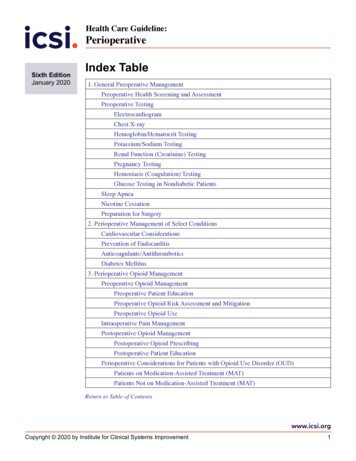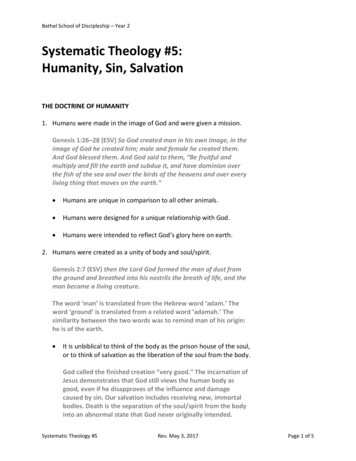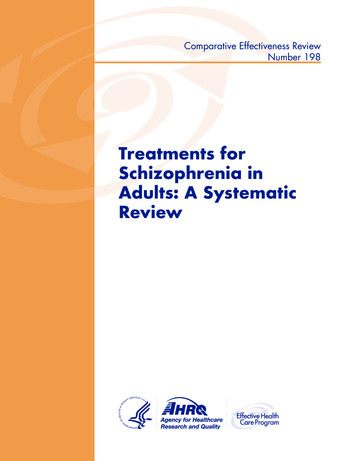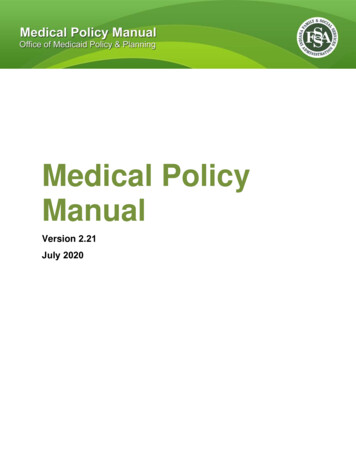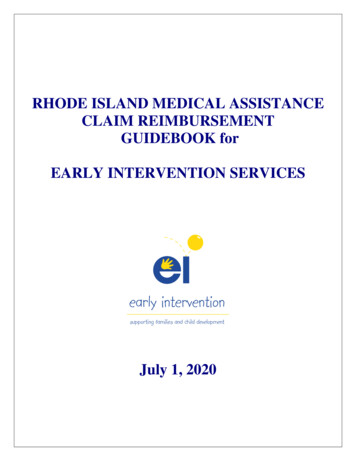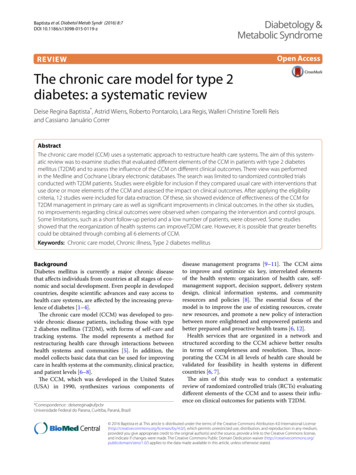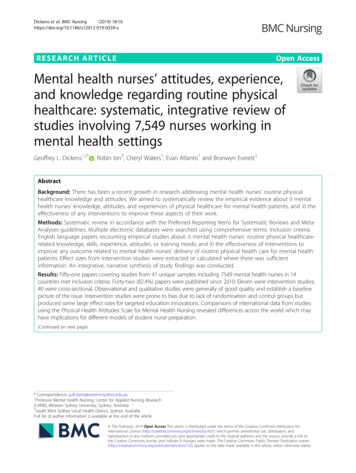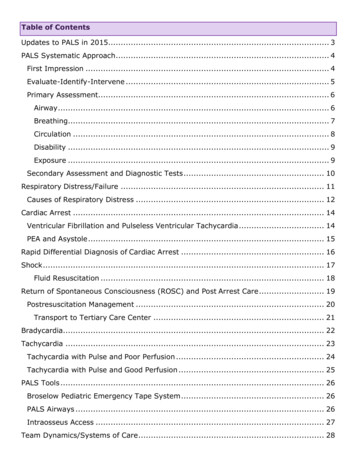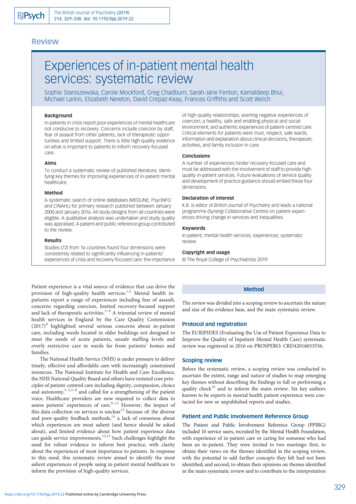
Transcription
The British Journal of Psychiatry (2019)214, 329–338. doi: 10.1192/bjp.2019.22ReviewExperiences of in-patient mental healthservices: systematic reviewSophie Staniszewska, Carole Mockford, Greg Chadburn, Sarah-Jane Fenton, Kamaldeep Bhui,Michael Larkin, Elizabeth Newton, David Crepaz-Keay, Frances Griffiths and Scott WeichBackgroundIn-patients in crisis report poor experiences of mental healthcarenot conducive to recovery. Concerns include coercion by staff,fear of assault from other patients, lack of therapeutic opportunities and limited support. There is little high-quality evidenceon what is important to patients to inform recovery-focusedcare.of high-quality relationships; averting negative experiences ofcoercion; a healthy, safe and enabling physical and socialenvironment; and authentic experiences of patient-centred care.Critical elements for patients were trust, respect, safe wards,information and explanation about clinical decisions, therapeuticactivities, and family inclusion in care.AimsA number of experiences hinder recovery-focused care andmust be addressed with the involvement of staff to provide highquality in-patient services. Future evaluations of service qualityand development of practice guidance should embed these fourdimensions.To conduct a systematic review of published literature, identifying key themes for improving experiences of in-patient mentalhealthcare.ConclusionsMethodA systematic search of online databases (MEDLINE, PsycINFOand CINAHL) for primary research published between January2000 and January 2016. All study designs from all countries wereeligible. A qualitative analysis was undertaken and study qualitywas appraised. A patient and public reference group contributedto the review.Declaration of interestK.B. is editor of British Journal of Psychiatry and leads a nationalprogramme (Synergi Collaborative Centre) on patient experiences driving change in services and inequalities.KeywordsResultsIn-patient; mental health services; experiences; systematicreview.Studies (72) from 16 countries found four dimensions wereconsistently related to significantly influencing in-patients’experiences of crisis and recovery-focused care: the importanceCopyright and usagePatient experience is a vital source of evidence that can drive theprovision of high-quality health services.1,2 Mental health inpatients report a range of experiences including fear of assault,concerns regarding coercion, limited recovery-focused supportand lack of therapeutic activities.3–8 A triennial review of mentalhealth services in England by the Care Quality Commission(2017)9 highlighted several serious concerns about in-patientcare, including wards located in older buildings not designed tomeet the needs of acute patients, unsafe staffing levels andoverly restrictive care in wards far from patients’ homes andfamilies.The National Health Service (NHS) is under pressure to delivertimely, effective and affordable care with increasingly constrainedresources. The National Institute for Health and Care Excellence,the NHS National Quality Board and others have restated core principles of patient-centred care including dignity, compassion, choiceand autonomy,3–5,5–8 and called for a strengthening of the patientvoice. Healthcare providers are now required to collect data toassess patients’ experiences of care.9–12 However, the impact ofthis data collection on services is unclear13 because of: the diverseand poor-quality feedback methods,14 a lack of consensus aboutwhich experiences are most salient (and hence should be askedabout), and limited evidence about how patient experience datacan guide service improvements.13,15 Such challenges highlight theneed for robust evidence to inform best practice, with clarityabout the experiences of most importance to patients. In responseto this need, this systematic review aimed to identify the mostsalient experiences of people using in-patient mental healthcare toinform the provision of high-quality services. The Royal College of Psychiatrists 2019.MethodThe review was divided into a scoping review to ascertain the natureand size of the evidence base, and the main systematic review.Protocol and registrationThe EURIPIDES (Evaluating the Use of Patient Experience Data toImprove the Quality of Inpatient Mental Health Care) systematicreview was registered in 2016 on PROSPERO: CRD42016033556.Scoping reviewBefore the systematic review, a scoping review was conducted toascertain the extent, range and nature of studies to map emergingkey themes without describing the findings in full or performing aquality check16 and to inform the main review. Six key authorsknown to be experts in mental health patient experience were contacted for new or unpublished reports and studies.Patient and Public Involvement Reference GroupThe Patient and Public Involvement Reference Group (PPIRG)included 10 service users, recruited by the Mental Health Foundation,with experience of in-patient care or caring for someone who hadbeen an in-patient. They were invited to two meetings: first, toobtain their views on the themes identified in the scoping review,with the potential to add further concepts they felt had not beenidentified; and second, to obtain their opinions on themes identifiedin the main systematic review and to contribute to the 22 Published online by Cambridge University Press
Staniszewska et alTable 1Reporting Patient and Public Involvement in the EURIPIDES study using GRIPP2aGRIPP2 Short Form itemDescriptionAims:Report the aim of Patient and Public Involvement in the study(a) Ensure there is a patient voice included at all stages of the EURIPIDES study;(b) to discuss the scoping study themes and to identify additional ones service users feel areimportant;(c) to discuss the themes and sub-themes identified in the main review to ensure face andcontent validity.Methods:Provide a clear description of the methods used for Patientand Public Involvement in the studyThe Patient and Public Involvement Reference Group was established by the Mental HealthFoundation. Members were varying in background and experience. The Group metregularly and at key points during the study. The group were facilitated by D.C.-K. whoensured they felt able and were supported to contribute and challenge methods.The Patient and Public Involvement Reference Group provided a strong patient and carerperspective. They critiqued the content of the themes identified in the scoping review,identifying additional areas such as boredom. They provided content and face validity ofthe themes and sub-themes identified in the main review. They provided real life examplesof the themes from their own experiences. The Patient and Public Involvement ReferenceGroup also checked if the themes from international studies resonated in a UK context.The Patient and Public Involvement Reference Group was important in confirming thesystematic review had identified the themes of importance to patients and carers. Thiswas particularly important because the strength of the patient voice was uncertain in thepapers reviewed.The Patient and Public Involvement Reference Group worked well in the study. On reflectionmore embedded forms of involvement, with members of the group working more closelyon the analysis, may have embedded the service user voice more strongly into the studyand could have created the conditions for the co-production of knowledge and possiblyadditional sub-themes.Study result outcomes:Report the results of Patient and Public Involvement in thestudy, including both positive and negative outcomesDiscussion and conclusion outcomes:Comment on the extent to which Patient and PublicInvolvement influenced the study overall. Describe positiveand negative effectsReflections/critical perspective:Comment critically on the study, reflecting on the things thatwent well and those that did not, so others can learn fromthis experiencea. Staniszewska S, Brett J, Simera I, Seers K, Mockford C, Goodlad S, Altman DG, Moher D, Barber R, Denegri S, Entwistle A, Littlejohns P, Morris C, Suleman R, Thomas V, Tysall C. GRIPP2reporting checklist: tools to improve reporting of patient and public involvement in research. BMJ 2017; 358: j3453.of our findings. A full description of the patient involvement in thestudy is reported using the GRIPP2 Short Form Checklist in Table 1.findings related to key concepts and any other emerging concepts (C.M.).Identification of studies for the systematic reviewQuality and risk of bias in individual studiesGuided by the themes that emerged from the scoping review, searchterms and a search strategy were developed and applied to the databases MEDLINE, CINAHL and PsycINFO. An example of searchterms and results is reported in Fig. 1. Reference lists of includedpapers were scanned. The search deviated from the protocol in thatonly three of five databases were searched due to the large numbersof abstracts retrieved (Web of Science and Embase were not used).The quality of the studies were evaluated by the Critical Appraisal SkillsProgramme (CASP) Qualitative Checklist,17 undertaken by C.M.Because of the heterogeneity of the included studies, many of whichwere descriptive in their approach, this checklist provided an appropriate basis for comparison between studies. The only question change inthe CASP checklist was from ‘Is the qualitative methodology appropriate for this study?’ to ‘Is the methodology appropriate for this study?’Inclusion and exclusion criteriaData analysisAll study designs were considered if papers included experiences ofcurrent or former in-patients of mental health institutions. Norestrictions were applied based on country. Articles were includedif they reported primary research, were peer reviewed and publishedin English between January 2000 and January 2016. Papers wereexcluded if they were not primary studies, based on pre-2000data, included children and adolescents (aged under 18 years) orwere not in the English language. Where study participants includedboth in- and out-patients, only data regarding in-patient experiences were extracted. Reviews (Table A.1) were noted and referencelists scanned, but excluded from the review to avoid bias.The scoping review informed the development of a thematic framework, which guided but did not restrict the review. A narrative synthesis of the themes was undertaken.18 As the researcher read eachstudy, an initial preliminary synthesis of the study was undertakenand emerging sub-themes were identified. The researcher was thenable to compare themes and sub-themes within and across studiesand further develop them into the main themes. Themes were summarised in a descriptive form, allowing for the findings of all reviewstudies, regardless of study design, to be aggregated and summarised.We used the concept of data saturation to help us decide when tocomplete data extraction. Saturation of data is judged to have happened at a point where no new themes are being identified in thestudies when compared with what has already been extracted.7 Itis a useful approach for large reviews where the addition of furtherpapers is unlikely to change key findings.Study selectionTitles and abstracts were screened (C.M., G.C.), 20% of which wereindependently cross-checked for agreement before obtaining fulltext articles (S.S. and C.M.). Full texts were obtained where theabstract was unclear. Any disagreements could be resolved by consensus (C.M., G.C. and S.S.) but no disagreements occurred.ResultsPPIRGData extractionThe data extracted, using Microsoft Excel (version 2013), includedcitation details, sample recruitment and research methods,330https://doi.org/10.1192/bjp.2019.22 Published online by Cambridge University PressKey themes identified in the scoping review were discussed in detailby group members who critiqued their content and identified additional areas such as boredom. The PPIRG provided content and
Experiences of in-patient mental health servicesResultsSearch typeActions1exp Inpatients/ or inpatient*.mp.73 8202service user*.mp.3patient/4exp "Commitment of Mentally Ill"/5involuntary.mp.10 99661 or 2 or 3 or 4 or 5108 7667exp Hospitals, Psychiatric/ or psychiatric.mp.218 3118psychiatry.mp. or Psychiatry/74 1879Mental Disorders/139 896107 or 8 or 9341 43311exp Patient Satisfaction/67 50512(satisf* or experience*).mp. [mp title, abstract, original title, name of substance word,930 899255617 8696286subject heading word, keyword heading word, protocol supplementary concept word,rare disease supplementary concept word, unique identifier]1311 or 12933 891146 and 10 and 13320415limit 14 to yr "2000–Current"218116limit 15 to english language1943Fig. 1 Example of search strategy from MEDLINE.face validity for the identified themes and provided real-life examples of the themes from their own experiences. The PPIRG also provided an opportunity to check if the themes identified frominternational studies resonated in a UK context.The systematic reviewA total of 4979 abstracts were screened and 116 papers fulfilled theinclusion criteria (Fig. 2). Two consecutive sifts were conducteddue to an error in the first search of the PsycINFO database omitting 2980 hits which was identified after the first sift was completed. The first sift of 1999 hits resulted in 72 relevant papersfor the review; 11 papers were from same studies.19–29 Followingthis, the second sift of 2980 abstracts resulted in an additional 44studies fitting the criteria (total n 116). Drawing on the principles of data saturation,30 additional studies that repeated themesalready identified were excluded from the main review. In total,eight studies added new themes and were included at this stage.331https://doi.org/10.1192/bjp.2019.22 Published online by Cambridge University Press
Records identified through database searching(n 12 622)After duplicates removed(n 5928)Records screened(n 4979)Records excluded attitle/abstract sift (n 4539)Records screened(n 440)Records excluded at second stagetitle/abstract sift (n 235)Full-text articles assessed foreligibility (n 205)Full-text articles excluded,with reasons (n szewska et alLiterature reviews: 16Not fulfilling criteria: 13Pre-2000 data: 16Intervention type: 11Individual treatment: 8Testing a new instrument: 2Carer experiences: 5Complaints: 1Studies satisfying inclusioncriteria (n 122)Studies fulfilling inclusion criteriabut not included due to datasaturation (n 44)Importance of relationships in mentalhealth care: 25Experience of coercion: 10Physical environment and the milieu: 3Patient centred care: 6Fig. 2 PRISMA (Preferred Reporting Items for Systematic Reviews and Meta-Analyses) 2009 flow diagram.A total of 16 systematic reviews (Table A.1) which investigatedin-patient experience were identified. In total, 72 studieswere included in the review, a third of which were from theUK24–47 (n 24)19–21,25,27,31–49 (Supplementary Table 1 availableat https://doi.org/10.1192/bjp.2019.22). Although studies usingqualitative methods were most common (Table A.1), studies usingpatient experience questionnaires and patient record data werealso included. The CASP checklist identified many of the papersas being of medium to poor quality.Identification of key themesPatient experiences were categorised into four overarching themesor dimensions of experience: the importance of high-quality relationships; averting negative experiences of coercion; a healthy,safe and enabling physical environment and ward milieu; andauthentic experiences of patient-centred care. These key themesaccompanied by sub-themes are described in detail below.The importance of high-quality relationshipsTiming of data collection in included studiesLittle information was provided about the timing of data collection inover a third of papers (37%), other than describing participants as inpatients at the time.25–27,31,32,35,36,43,44,48–63 Data were mostly collectedjust before,28,29,45,64–73 immediately after discharge20,45,59,74,75 or fromformer 0 This suggests thatpatients were recovering when experiences were elicited. In threestudies, data collection coincided with a ward event (e.g. refurbishment).81–83 A number of studies (n 12, 17%) collected data shortlyafter an event such as admission,19,21,84–86 seclusion, sedation 2/bjp.2019.22 Published online by Cambridge University PressThe importance of high-quality relationships was the most consistently reported theme.Important factors in developing such relationships with staffincluded being treated with respect, feelings of stability, recognisingempathy and high-quality 1,63,78,87,90with staff who patients felt were trustworthy,reliable35,63,69 or helpful.27,51,54,62 Good staff–patient relationshipsfacilitated the in-patient care pathway in mental health institutions28,35,39,51,68 and reduced the use of coercive measures.35,45,78Ward rounds were an important setting for staff–patient interactionand patients reported these as helpful and informative.44
Experiences of in-patient mental health servicesPotential barriers to therapeutic relationships included: genderspecific problems – male nursing staff were not welcome if thepatient had a history of abuse by male perpetrators36,78 or wheregender-specific cultural barriers existed (e.g. a Muslim womansupervised by a male nurse);68 lack of meaningful communication– where communication was compromised due to differences inculture, language, religion,34,39,57,68 through use of coercive measures33,60 or where technical language used by staff was not easilyunderstood;19 absence of regular ward staff – patients were upset bythe absence of regular ward staff due to office duties, shift working,reliance on temporary staff23,24,27,28,35–37,39,45,46,51,54,55,63,69 andhaving extended waits to speak to staff24,36,46,54,77,80,82 particularlyat ward rounds;43 poor staff attitude – where patients complainedthat staff ignored them,57,87,88,91 displayed indifference24 or insufficient understanding of patients;78 inconsistent staff behaviour –reports of staff interpreting ward rules inconsistently, causingconfusion;19,23,27,31,33,36,46,49,82,91 staff abuse – some patients reportedabuse by staff, including provocation, bullying, shouting or belittlingof ationships with other patients and with relatives:Patients relied on other patients for information about ward activities and rules, to share experiences and when debriefing after groupsessions.22,45,77,82,83 However, arguments and violence betweenpatients36,39,48 generated fear and isolation for some, causingthem to retreat to their rooms for safety or to abscond.23,37,39,49,65,80Isolation from family caused distress. Patients reported thathaving a friend or family member with them would have helpedwith orientation79 and they could have helped staff with assessmentsand treatment plans.22,38,53 However, family members felt left out ofdecision-making about care.92Averting negative experiences of coercionThe second main theme was concerned with experiences of coercion. All patients expected to be treated as ‘normal humanbeings’24,29,77 and addressed professionally, including duringrestraint.87 Patients wanted the reasons for coercive measures tobe communicated so they could understand them as this helpedsome patients trust staff and feel safe.46,67,75,79,87 Patients valuedpersuasion over threats of force60 and coercion,78 which couldbring back memories of past history of violence and neglect.33,88,89Where coercive measures were discussed in the studies, theseincluded experiences of sedation, seclusion and restraint. It hasbeen reported that Black and minority ethnic patients are morelikely to experience coercion than White patients.Ethnicity: Two studies examined the commonly held perceptionthat Black and minority ethnic patients experienced more coercionon admission than other patients.21,74 The findings were not conclusive: although hospitals in the UK with higher proportions of Blackand minority ethnic patients employed more coercive practices, thiswas independent of individual patient ethnicity.21,74Sedation: Some patients recognised that medication was important for the in-patient care pathway.20,39,41 Some trusted staff to decideon appropriate sedation,32,52 whereas others felt empowered to decideon timing and dose of medication when administered on an ‘asneeded’ basis.32 However, patients also voiced concerns that includedlack of communication about consent, information about medicationand advanced wishes;39,52 lack of confidentiality regarding medication;32,42 perceived overmedication32,39,41,46,47,52,69 (including overlooked or ignored reports of side effects);28,41 and fear of harmduring forced medication,20,32,39,54,60,78 for example patients in crisisreported a fear of being raped by staff or of dying.20,41,78,88Seclusion: Some patients reported seclusion as helpful or necessary24,57,79,88 and that they felt safe as staff were nearby.24,57,88,90Patient concerns included having insufficient information aboutthe reasons for seclusion23,24,46,57,88 before or after the event.24,57Seclusion was perceived as a punishment79 and associated withlimited contact;57,88 lack of concern by staff;89 degradation andhumiliation, e.g. lack of facilities24,57,89 or being stripped of clothingin front of staff members;61,79,89,91 and violation of rights88 anddignity.61Restraint: Restraint was described as forcible manual or mechanical restraint and typically involved several staff, mostlynurses23,60,78,88,92 but occasionally security staff.78,92 Restraint wasdescribed negatively25,33,78 and fear of restraint prevented patientsfrom seeking help earlier.33 There was a risk of harm if mechanicalrestraints were used,87 although these were not used in all countries.Talking with staff following restraint or being allowed to examinerecords of the event was considered helpful.33In addition to the use of coercive measures, patients alsodescribed perceived punishment by staff19,35,41,80,91 in the form ofthe removal of leave entitlements,35 removal of furniture and personal items41,91 and not being able to stay up in the evening.19,80Patients described this as a violation of their rights.23,57,58,88A healthy, safe and enabling physical environment and ward milieuThe third main theme focused on a healthy, safe and enabling environment. This contributed to how relatives felt when visiting,92 howpatients felt about themselves39 and how they reacted to treatment.36,39,42 Johansson et al (2003)63 argued that the physical environment was as important to patients as receiving satisfactory care.A number of studies reported that patients saw hospital as a ‘sanctuary’80 or a ‘safe space’62 where they could have time to reflect awayfrom day-to-day stressors,38,50 be kept safe19,39,48,54 and experiencea caring, therapeutic environment.80Patients felt that their in-patient care pathway was aided by connection to the ‘real world’61 and that being made to feel‘normal’24,28,51,77 was important. This included being allowed towalk around hospital grounds.39,80 Older establishments often hadextensive grounds and patients reported that access to thesespaces resulted in less need for medication.32 Access to a place ofworship was comforting,51,68 as was freedom to make smalldecisions31,41 such as making snacks62 or hot drinks.36 Private bedrooms were important,80 being near windows enabled ward-boundpatients to enjoy the outside and fresh air,83 and appropriate use ofcolour was described as conducive to recovery.80 An environmentwhere staff and patients mixed together reduced feelings ofstigma51 and encouraged favourable interactions.63Patients reported several environmental problems that were notconducive to recovery-focused care. Some of these were associatedwith arguments and violence between patients.36,39,48 Other environmental problems included noise from doorbells, alarms and telephones.82 Poor positioning of the nurses’ stations often createdphysical divisions between patients and staff, reducing interaction.61,80,92 Communal spaces sometimes lacked privacy for visiting relatives or opportunities for physical activity,49 especially forthose under close observation.92There were also contradictory reports. In several studies,some patients described hospital as a place of confinement ratherthan therapy.19,29,36,37,39,42,80 There were analogies withprison29,36,39,42,80 and punishment.37,39 This was particularly so in333https://doi.org/10.1192/bjp.2019.22 Published online by Cambridge University Press
Staniszewska et alsecure units with a lack of outside space39 and where more patientswere admitted compulsorily.29Ward milieu: Related to environment was the experience ofward milieu, which was shaped by the conduct of staff. Staff provided structure, order and safety82 and were responsible for creatinga congenial atmosphere.54 Feeling safe was a prime concern topatients48,65 who perceived wards to be safe when they viewedstaff as trustworthy,35 caring and supportive.35,38 Wards were sometimes criticised as being too busy36,49,54 and reactive to events suchas restraint,56,79,92 seclusion91 or violence.23,58,80 Patients felt vulnerable to the latter,23,37,39 fearful of other patients49,78 and worriedabout security of belongings.36,65,80 Fear contributed to withdrawingwithin the ward49,81 or leaving hospital.37,80Ward routines also shaped patients’ experiences. The day51 wasoften structured to include individual and group therapies as well asother activities, e.g. puzzles, conversation or listening to music.92Evenings were typically less structured.51 Some patients relishedthe leisure time24,38,50,54 and some took this as a time for personalreflection.38,51,57 However, others were uneasy38,51 and reportedinsufficient36,49 activity. 23,24,39,49, 68 The location of the hospital –being close to family – was important to patients79 and they appreciated the inclusion of, and support from, families.22,38,53Boredom: ‘Boredom’ or having little to do was mentioned inseveral studies.23,24,27,41,51,54,59,68,80,82,83,91 Patients suggested thatinactivity slowed the in-patient care pathway,59 reduced selfefficacy,41 exacerbated symptoms80 and was related to aggressionand violence on the ward.23 Some patients reported that inactivityencouraged poor health outcomes, e.g. saying that they would eat,sleep or smoke but not exercise.24,59,80,83Authentic experiences of patient-centred careThe final theme brought together a collection of sub-themes focusedon authentic experiences of patient-centred care, which includedshared decision-making, sensitivity to gender and culture and theprovision of information.Shared decision-making: Two studies reported that patients’involvement in treatment decisions was associated with positiveexperiences of care.50,65Gender and cultural differences: Patients wanted to beunderstood and seen as individuals, and this was framed inrespect of their gender, ethnicity and religion.33,34,68,78 Somepatients described cultural differences in perceptions of privacy,and reported concern that staff had not recognised or respondedto their discomfort in accepting care from differently genderedstaff,68 for example during restraint and sedation,33 or for womenwith a history of sexual abuse by male perpetrators.78 More positively, female patients tended to prefer single-gender wards(where they felt safer36). Where this was not available, femalepatients were satisfied on mixed wards if they had access to aquiet room, if their privacy was respected and if they had accessto personal hygiene products.81 Faith also mattered: prayer andrituals (e.g. hand washing) offered comfort to some patients68 butwere not always understood or accommodated by staff.34Provision of information: There were several reports in whichpatients felt they had not received sufficient information about theirdiagnosis,23,65,69,87 treatment,20 treatment plan,23,32,52,57,60,65,69,87,88,90,91choices or rights.20,46,53,64,86 Timing was also important as patientsfound it difficult to understand or remember this information 9.22 Published online by Cambridge University PressDiscussionThe aim of this review was to identify the most salient aspects of inpatient experience to support improvements in care in ways that areconducive to recovery-focused care. To the best of our knowledgethis is the largest review of its type in the UK and internationally,with 72 included studies, of which a third were from the UK.A strength of the review was the involvement of the PPIRG whoprovided important face and content validity checks and wereable to identify additional areas of experience, such as boredom,which could be built into the main review.The review makes an important contribution to the field ofmental health in-patient experiences through the identification offour key, interlinked themes: the importance of high quality relationships; averting negative experiences of coercion; a healthy,safe and enabling physical environment and ward milieu; andauthentic experiences of patient-centred care. These themes andtheir associated sub-themes represent the active ingredients of ahigh-quality mental health in-patient experience (as well as thecommon causes of very poor experiences). The identified themescan be used to design and deliver high-quality services, providecontent for the development of robust patient experience questionnaires or inform qualitative methods that aim to evaluate salientaspects of patient experience. They provide evidence for the development of practice guidance that supports the implementation ofhigh-quality services.A consistent thread across
study, an initial preliminary synthesis of the study was undertaken and emerging sub-themes were identified. The researcher was then able to compare themes and sub-themes within and across studies and further develop them into the main themes. Themes were sum-marised in a descriptive form, allowing for the findings of all review
